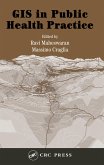Geospatial Information System Use in Public Organizations (eBook, ePUB)
How and Why GIS Should be Used in the Public Sector
Redaktion: Valcik, Nicolas A.


Alle Infos zum eBook verschenken

Geospatial Information System Use in Public Organizations (eBook, ePUB)
How and Why GIS Should be Used in the Public Sector
Redaktion: Valcik, Nicolas A.
- Format: ePub
- Merkliste
- Auf die Merkliste
- Bewerten Bewerten
- Teilen
- Produkt teilen
- Produkterinnerung
- Produkterinnerung

Hier können Sie sich einloggen

Bitte loggen Sie sich zunächst in Ihr Kundenkonto ein oder registrieren Sie sich bei bücher.de, um das eBook-Abo tolino select nutzen zu können.
This book shows how Geospatial Information Systems (GIS) can be used for operations management in public institutions. It covers theory and practical applications, ranging from tracking public health trends to mapping transportation routes to charting the safest handling of hazardous materials. Along with an expert line-up of contributors and case studies, the editor provides a complete overview of how to use GIS as part of a successful, collaborative data analysis, and how to translate the information into cost-saving decisions, or even life-saving ones.
- Geräte: eReader
- mit Kopierschutz
- eBook Hilfe
![Geospatial Information System Use in Public Organizations (eBook, PDF) Geospatial Information System Use in Public Organizations (eBook, PDF)]() Geospatial Information System Use in Public Organizations (eBook, PDF)32,95 €
Geospatial Information System Use in Public Organizations (eBook, PDF)32,95 €![Diplomacy, Society and the COVID-19 Challenge (eBook, ePUB) Diplomacy, Society and the COVID-19 Challenge (eBook, ePUB)]() Diplomacy, Society and the COVID-19 Challenge (eBook, ePUB)39,95 €
Diplomacy, Society and the COVID-19 Challenge (eBook, ePUB)39,95 €![GIS in Public Health Practice (eBook, ePUB) GIS in Public Health Practice (eBook, ePUB)]() GIS in Public Health Practice (eBook, ePUB)64,95 €
GIS in Public Health Practice (eBook, ePUB)64,95 €![Migrant Health and Resilience (eBook, ePUB) Migrant Health and Resilience (eBook, ePUB)]() Peter H. KoehnMigrant Health and Resilience (eBook, ePUB)41,95 €
Peter H. KoehnMigrant Health and Resilience (eBook, ePUB)41,95 €![Monitoring the Health of Populations by Tracking Disease Outbreaks (eBook, ePUB) Monitoring the Health of Populations by Tracking Disease Outbreaks (eBook, ePUB)]() Steven E RigdonMonitoring the Health of Populations by Tracking Disease Outbreaks (eBook, ePUB)33,95 €
Steven E RigdonMonitoring the Health of Populations by Tracking Disease Outbreaks (eBook, ePUB)33,95 €![The Global Impact of the COVID-19 Pandemic on Institutional and Community Corrections (eBook, ePUB) The Global Impact of the COVID-19 Pandemic on Institutional and Community Corrections (eBook, ePUB)]() The Global Impact of the COVID-19 Pandemic on Institutional and Community Corrections (eBook, ePUB)41,95 €
The Global Impact of the COVID-19 Pandemic on Institutional and Community Corrections (eBook, ePUB)41,95 €![Health Security Intelligence (eBook, ePUB) Health Security Intelligence (eBook, ePUB)]() Health Security Intelligence (eBook, ePUB)41,95 €
Health Security Intelligence (eBook, ePUB)41,95 €-
-
-
Dieser Download kann aus rechtlichen Gründen nur mit Rechnungsadresse in A, B, BG, CY, CZ, D, DK, EW, E, FIN, F, GR, HR, H, IRL, I, LT, L, LR, M, NL, PL, P, R, S, SLO, SK ausgeliefert werden.
- Produktdetails
- Verlag: Taylor & Francis eBooks
- Seitenzahl: 286
- Erscheinungstermin: 11. September 2019
- Englisch
- ISBN-13: 9781000651195
- Artikelnr.: 57789512
- Verlag: Taylor & Francis eBooks
- Seitenzahl: 286
- Erscheinungstermin: 11. September 2019
- Englisch
- ISBN-13: 9781000651195
- Artikelnr.: 57789512
- Herstellerkennzeichnung Die Herstellerinformationen sind derzeit nicht verfügbar.
Introduction 1. Introduction. Section II: Academic and Theoretical Research
GIS Topics 2. Hurricane Rita's Impact on Vegetation: A Spatio-Temporal
Statistical Approach to Characterizing Abrupt Change in, and Potential
Disaster Management for, Target Areas. 3. Evolving Trajectories in Public
Sector Statewide Spatial Data Infrastructure: From Data Product to
On-Demand Services and GIS Apps. 4. Using Geospatial Information Systems to
Preposition Logistics in Preparation for Hazardous Materials Incidents for
Disaster Response and Homeland Security Purposes. 5. Fire Disturbance and
Implications for Ecosystem Services Distribution in Northern Amazonia. 6.
Understanding Threats to Crowdsourced Geographic Data Quality Through a
Study of OpenStreetMap Contributor Bans. Section III: Applied Research
Using GIS 7. More Than Meets the Eye: The Methodological and
Epistemological Hazards of GIS Map Use in the Public Sphere. 8. Protecting
Surface Water Drinking Supplies in WV With Zones of Critical Concern.
Section IV: Practitioner Use of GIS in Public and Nonprofit Organizations
9. Uses of Geospatial Information Systems (GIS) for Public Higher Education
Institutions. 10. The Logistical Tracking System (LTS) Eighteen Years
Later: What Did We Learn and What Could We Improve? 11. Trends and
Challenges for Geographic Information Systems (GIS) Use by Nonprofits. 12.
West Virginia Trail Inventory. 13. One Government: The Enterprise Approach
in a Silo Environment. 14. GIS Practices for Best-Run County Governments.
15. Using GIS for Enrollment Management and Campus Management at a Public
University. Section V: Conclusion 16. Conclusion. Index.
Introduction 1. Introduction. Section II: Academic and Theoretical Research
GIS Topics 2. Hurricane Rita's Impact on Vegetation: A Spatio-Temporal
Statistical Approach to Characterizing Abrupt Change in, and Potential
Disaster Management for, Target Areas. 3. Evolving Trajectories in Public
Sector Statewide Spatial Data Infrastructure: From Data Product to
On-Demand Services and GIS Apps. 4. Using Geospatial Information Systems to
Preposition Logistics in Preparation for Hazardous Materials Incidents for
Disaster Response and Homeland Security Purposes. 5. Fire Disturbance and
Implications for Ecosystem Services Distribution in Northern Amazonia. 6.
Understanding Threats to Crowdsourced Geographic Data Quality Through a
Study of OpenStreetMap Contributor Bans. Section III: Applied Research
Using GIS 7. More Than Meets the Eye: The Methodological and
Epistemological Hazards of GIS Map Use in the Public Sphere. 8. Protecting
Surface Water Drinking Supplies in WV With Zones of Critical Concern.
Section IV: Practitioner Use of GIS in Public and Nonprofit Organizations
9. Uses of Geospatial Information Systems (GIS) for Public Higher Education
Institutions. 10. The Logistical Tracking System (LTS) Eighteen Years
Later: What Did We Learn and What Could We Improve? 11. Trends and
Challenges for Geographic Information Systems (GIS) Use by Nonprofits. 12.
West Virginia Trail Inventory. 13. One Government: The Enterprise Approach
in a Silo Environment. 14. GIS Practices for Best-Run County Governments.
15. Using GIS for Enrollment Management and Campus Management at a Public
University. Section V: Conclusion 16. Conclusion. Index.







